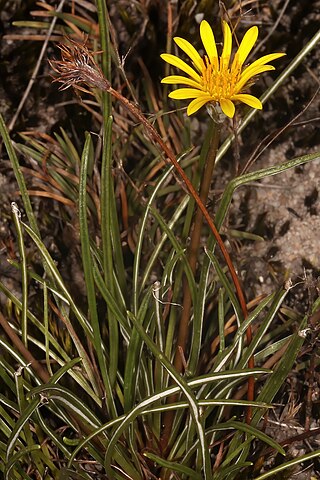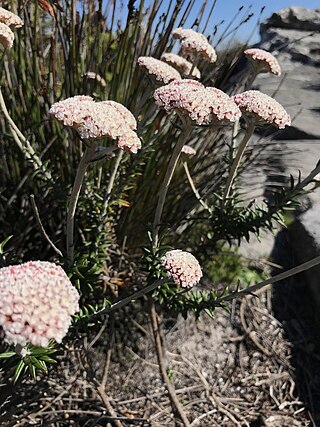
Felicia amelloides, the blue daisy bush or blue felicia, is a hairy, soft, usually perennial, evergreen plant, in the family Asteraceae. It can be found along the southern coast of South Africa. It grows as ground cover and produces many very regular branches. It mostly grows to about 50 cm (1.6 ft) high, rarely to 1 m. The leaves are oppositely arranged along the stems, dark green in colour and elliptic in shape. The flower heads sit individually on up to 18 cm (7 in) long, green to dark reddish stalks. They consist of about twelve heavenly blue ray florets that surround many yellow disc florets, together measuring about 3 cm across. It is also cultivated as an ornamental, and was introduced in Europe in the middle of the 18th century.

Gazania linearis is a species of flowering plant in the family Asteraceae, with thin linear leaves, native to South Africa.

Phaneroglossa is a genus of plants that is assigned to the daisy family. It consists of only one species, Phaneroglossa bolusii, a perennial plant of up to 40 cm high, that has leathery, line- to lance-shaped, seated leaves with mostly few shallow teeth and flower heads set individually on top of long stalks. The flower head has an involucre of just one whorl of bracts, few elliptic, white or cream ray florets, and many yellow disc florets. It is an endemic species of the Western Cape province of South Africa. Flowering mainly occurs from November to January.

Felicia josephinae is a roughly hairy annual herbaceous plant of 15–20 cm (6–8 in) high, that is assigned to the family Asteraceae. It branches near its base, and has few leaves along its stems. The lower leaves are set oppositely, inverted lance-shaped, relatively large at 3–7 cm long and ⅔–1¼ cm wide, and soon withering, while the higher ones are smaller and relatively narrower. In the axils of the leaves grow flower heads of 7–8 mm wide on stalks of up to 5 cm (2 in) long, topped with an involucre of about 5 mm (0.2 in) high and 4 mm (0.16 in) wide, consisting of eleven to thirteen bracts in two rows with bristles near the tip, eight to nine white or cream-coloured ligulate florets surrounding fourteen or fifteen deep purple disc florets. Flowers can be found in September and October. The species is an endemic species that can only be found in a small area along the west coast of the Western Cape province of South Africa.

Felicia nordenstamii is a flowering shrub in the family Asteraceae. It is found only in South Africa where it grows on limestone hills close to the sea on the southern coast. Felicia nordenstamii is a many-branched shrub growing up to 30 cm (1 ft) tall. The lower parts of the stems are covered in grayish brown bark and the upper stem has many crowded, upwardly angled, alternate leaves with long hairs on the lower surfaces. Large flower heads form at the tips of the branches, each about 41⁄2 cm across, with about thirty purplish blue ray florets surrounding many yellow disc florets.
Felicia clavipilosa is an upright, richly branched shrub of up to 60 cm (2 ft) high, that is assigned to the family Asteraceae. It has alternately arranged leaves, and flower heads with 3–4 whorls of involucral bracts with many yellow disc florets in the centre. Very characteristic for the species are the short club-shaped hairs on its fruits. There are two subspecies. Subsp. clavipilosa has narrowly lance-shaped entire leaves with one vein and pale mauve ray florets. Subspecies transvaalensis has lance-shaped leaves with one or three veins and white ray florets. The species occurs in southern Africa, with subsp. clavipilosa having a western distribution in Zambia, Zimbabwe, Namibia, Botswana and South Africa, and subsp. transvaalensis restricted to the east, from Zimbabwe, through Botswana to South Africa. The subspecies transvaalensis is sometimes called pokkiesblom in Afrikaans.
Printzia pyrifolia is a species of plant from South Africa.
Ursinia nudicaulis, also known as the longstalk paraseed or the little daisy is a species of plant from South Africa. It belongs to the daisy family.
Acrodon subulatus, the Overberg tiptoothfig, is a species of mesemb from South Africa.

Nolletia gariepina, the desert beesbossie, is a species of plant from southern Africa.

Helichrysum retortum, the flask everlasting or sea strawflower, is a species of plant from South Africa.
Athanasia grandiceps is a species of plant from South Africa. It belongs to the daisy family.

Syncarpha speciosissima, the Cape everlasting or Cape sewejaartjie, is a species of plant from South Africa.

Anaxeton arborescens, the northern paperposy, is a species of plant from South Africa. It grows in the fynbos biome.
Dicoma swazilandica is a species of plant from Eswatini and South Africa.
Amphiglossa corrudifolia is a species of plant from South Africa.
Thesium goetzeanum is a species of plant from Africa, where it grows between South Africa and Kenya.
Thesium lacinulatum is a species of plant from South Africa and Namibia.
Nemesia glaucescens is a species of plant endemic to South Africa. It belongs to the figwort family.
Nemesia grandiflora is a species of plant from South Africa.









